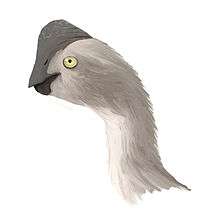Nemegtomaia
| Nemegtomaia Temporal range: Late Cretaceous, 70 Ma | |
|---|---|
 | |
| Skeletal diagram showing known remains of the holotype specimen (MPC-D 100/2112) | |
| Scientific classification | |
| Kingdom: | Animalia |
| Phylum: | Chordata |
| Class: | Reptilia |
| Clade: | Dinosauria |
| Order: | Saurischia |
| Suborder: | Theropoda |
| Family: | †Oviraptoridae |
| Subfamily: | †Oviraptorinae |
| Genus: | †Nemegtomaia Lü et al., 2005 |
| Species | |
| |
| Synonyms | |
| |
Nemegtomaia ("Nemegt mother") is a genus of oviraptorid dinosaur from the late Cretaceous Period of what is now Mongolia, about 70 million years ago. Nemegtomaia is estimated to have been around 2 m (7 ft) in length, and to have weighed 40 kg (85 lb).
Description
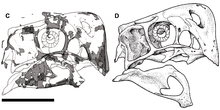
Nemegtomaia is estimated to have been around 2 m (7 ft) in length, and to have weighed 40 kg (85 lb).[1] The neural spines of the neck (cervical) vertebrae were short, and the neural arches had an x-shaped appearance. The middle three of these vertebrae were the largest.[2]
The skull of Nemegtomaia was deep, narrow, and short. It had a well-developed crest, formed by the nasal and premaxilla bones (mainly the latter) of the snout. The front margin of the crest was nearly vertical, and formed almost 90 degrees with the upper margin of the skull. Compared to other oviraptorids, the nasal processes (projections) of the premaxillae were barely visible when viewed from above (where they connected with the nasal bones on the highest points of the crest). The crest extended hindwards and down, forming a round arch at the highest point. The antorbital cavity in front of the eye consisted of two fenestrae (openings); a large antorbital fenestra at the back, and a small maxillary fenestra at the front. Nemegtomaia was distinct from other oviraptorids in the frontal bone on the midline of the skull being about 25% the length of the parietal bone from front to back. Another distinct feature was that the quadrate bone (at the back of the skull) had a convex surface that projected into the cotyla of the quadratojugal bone (where these bones contacted).[2]
The jaws of Nemegtomaia were toothless. As other oviraptorids, it had a short snout with a deep, blunt and somewhat parrot-like serrated beak. It had a hard palate formed by the premaxillae, vomers, and maxillae, like other oviraptorid dinosaurs. The palate was strongly concave (downwards-projecting), and had a cleft on the central part. As in other oviraptorids, the palatal parts of the maxillae each had a tooth-like projection that was directed downwards (a feature which has been called "pseudo-teeth"). Nemegtomaia had small foramina (openings) on the sides of the suture (joint) between the premaxillae at the font of the snout, which may have been nutrient openings. The lower jaw was short and deep, with a convex convex lower surface. The mandibular symphysis was short, deep, and very pneumatised (air-filled). The mandibular fenestra was large and was located at the front part of the lower jaw.[2][1] As in most other oviraptorids, the front part of the lower jaw was down-turned.[3]
History of discovery
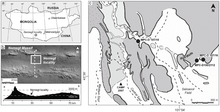
In 1996, the Japanese palaeontologist Yoshitsugu Kobayashi (as part of the "Mongolian Highland International Dinosaur Project" team) found an incomplete skeleton of an oviraptorid dinosaur in the Nemegt Formation in southwestern Mongolia. The specimen (MPC-D 100/2112 at the Mongolian Palaeontological Center, formerly PC and GIN 100/2112), consists of a nearly complete skull and a partial skeleton, including cervical, dorsal, sacral, and caudal vertebrae, a left scapula, the lower ends of both humeri, the right radius, both ilia, the upper ends of both pubes, both ischia, and the upper end of a femur. The specimen was described as a new specimen of the genus Ingenia (referred to as I. sp.; of uncertain species) by the Chinese palaeontologist Junchang Lü and colleagues in 2002, and used to highlight the similarities between oviraptorosaurs and birds.[4][2][5]
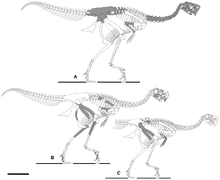
In 2004, Lü and colleagues found the skeleton to belong to a new, distinct taxon, and made it the holotype specimen of Nemegtia barsboldi. The genus name refers to the Nemegt Basin, and the species name honours the Mongolian palaeontologist Rinchen Barsbold, the leader of the team who found the specimen.[2] In 2005, the describers found (after being notified by a biologist) that the name Nemegtia had already been used for a genus of freshwater seed shrimp (Ostracoda) from the same formation in 1978, and was therefore preoccupied. Therefore, they instead proposed the new name Nemegtomaia; "maia", means "good mother" in Greek, in reference to the then recent discovery that oviraptorids brooded eggs rather than stealing them.[6] Similarly, Ingenia was renamed as Ajancingenia in 2013, since the former genus name was preoccupied by a roundworm (Nematoda).[7] The first known member of the oviraptorid family was found with a nest of eggs originally thought to have belonged to the ceratopsian genus Protoceratops, and was therefore named Oviraptor in 1924; this name means "egg-seizer". In the 1990s, more oviraptorid specimens were discovered associated with nests and eggs, wherein oviraptorid embryos were found, thereby proving that the eggs instead belonged to the oviraptorids themselves.[8][9]

In 2007, two new specimens of Nemegtomaia were found by the "Dinosaurs of the Gobi" expedition, and were described by the Italian palaeontologist Federico Fanti and colleagues in 2013. The first specimen, MPC-D 107/15, is from the Baruungoyot Formation, and consists of a nest with the presumed mother on top. As the fourth genus of oviraptorid found on top of a nest, Nemegtomaia therefore received a genus name referring to this feature before it was itself found associated with eggs. The skeleton preserves parts of the skull, both scapulae, the left arm and hand, the right humerus, the pubes, the ischia, the femora, the tibiae, fibulae, and the lower portions of both feet. It was found less than 500 m from the holotype, and was of the same size. It was collected in a single block, so that the spatial relationship of the bones and eggs would be preserved. The second specimen, MPC-D 107/16, is from the Nemegt Formation, and consists of the hands, a partial left ulna and radius, ribs, a partial pelvis, and both femora of a smaller individual.[5] Including Nemegtomaia, at least nine oviraptorid genera have been discovered in a relatively small geographical area in the Gobi Desert.[10]
Classification
Despite this early misidentification, Nemegtomaia belongs to the subfamily Oviraptorinae, not Ingeniinae and may be a close relative of Citipati.
The presence of a crest makes it unlikely to have been an ingeniine.[11]
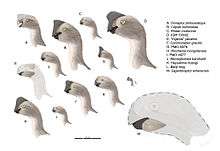
The cladogram below shows the placement of within Oviraptoridae, according to Fanti et al., 2012:[5]
| Oviraptoridae |
| |||||||||||||||||||||||||||||||||||||||||||||
| |
Palaeobiology
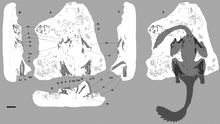
One of the specimens was found associated with a nest with eggs, and this specimen also showed evidence of having been scavenged upon by skin beetles.[5] Male oviraptorids may have nested rather than the females.[12]

It is unlikely that Nemegtomaia had a kinetic skull.[13] Oviraptorids appear to have retained their hind limb proportions throughout ontogeny.[14]
The tails of oviraptorosaurs may have had a fan of feathers.[15]
Palaeoecology
Nemegtomaia was discovered in the Nemegt Formation of southwestern Mongolia.[2] Many genera of oviraptorosaur are known from this formation, and may have been ecologically divided.[16] This geologic formation has never been dated radiometrically, but the fauna present in the fossil record indicate it was probably deposited during the early Maastrichtian stage, at the end of the Late Cretaceous about 70 million years ago.[17][18][19] The rock facies of the Nemegt Formation suggest the presence of stream and river channels, mudflats, and shallow lakes. Such large river channels and soil deposits are evidence of a far more humid climate than those found in the older Barun Goyot and Djadochta formations. However, caliche deposits indicate at least periodic droughts occurred. Sediment was deposited in the channels and floodplains of large rivers.[20]

The environment of the Nemegt Formation was similar to the Okavango Delta of present-day Botswana.[21] The habitats in and around the Nemegt rivers where Nemegtomaia lived provided a home for a wide array of organisms. Occasional mollusc fossils are found, as well as a variety of other aquatic animals like fish and turtles.[17] Nemegt crocodylomorphs included several species of Shamosuchus.[22] Mammal fossils are rare in the Nemegt Formation, but many birds have been found, including the enantiornithine Gurilynia, the hesperornithiform Judinornis, as well as Teviornis, a possible Anseriform. Herbivorous dinosaurs of the Nemegt Formation include ankylosaurids such as Tarchia, the pachycephalosaurian Prenocephale, large hadrosaurids such as Saurolophus and Barsboldia, and sauropods such as Nemegtosaurus, and Opisthocoelicaudia.[17][23] Predatory theropods include tyrannosauroids such as Tarbosaurus, Alioramus, and Bagaraatan, and troodontids such as Borogovia, Tochisaurus, and Saurornithoides. Theropod groups with both omnivorous and herbivorous members include therizinosaurs, such as Therizinosaurus, oviraptorosaurians, such as Elmisaurus and Rinchenia, and ornithomimosaurians such as Anserimimus and Gallimimus.[24]
See also
References
- 1 2 Paul, G. S. (2010). The Princeton Field Guide to Dinosaurs. Princeton University Press. pp. 152, 154. ISBN 978-0-691-13720-9.
- 1 2 3 4 5 6 Lü, J., Tomida, Y., Azuma, Y., Dong, Z. & Lee, Y.-N. (2004). "New oviraptorid dinosaur (Dinosauria: Oviraptorosauria) from the Nemegt Formation of southwestern Mongolia." Bulletin of the National Science Museum, Tokyo, Series C 30: 95-130.
- ↑ Lü, J.; Yi, L.; Zhong, H.; Wei, X.; Dodson, P. (2013). "A New Oviraptorosaur (Dinosauria: Oviraptorosauria) from the Late Cretaceous of Southern China and Its Paleoecological Implications". PLoS ONE. 8 (11): e80557. doi:10.1371/journal.pone.0080557. PMID 24312233.
- ↑ Lü, J., Dong, Z., Azuma, Y., Barsbold, R. & Tomida, Y. (2002). "Oviraptorosaurs compared to birds." In Zhou, Z. & Zhang, F. (eds). Proceedings of the 5th Symposium of the Society of Avian Paleontology and Evolution. Science Press (Beijing), pp. 175-189.
- 1 2 3 4 Fanti, F.; Currie, P. J.; Badamgarav, D.; Lalueza-Fox, C. (2012). "New Specimens of Nemegtomaia from the Baruungoyot and Nemegt Formations (Late Cretaceous) of Mongolia". PLoS ONE. 7 (2): e31330. Bibcode:2012PLoSO...731330F. doi:10.1371/journal.pone.0031330. PMID 22347465.
- ↑ Lü, J., Tomida, Y., Azuma, Y., Dong, Z. & Lee, Y.-N. (2005). "Nemegtomaia gen. nov., a replacement name for the oviraptorosaurian dinosaur Nemegtia Lü et al., 2004, a preoccupied name." Bulletin of the National Science Museum, Tokyo, Series C 31: 51.
- ↑ Easter, J. (2013). "A new name for the oviraptorid dinosaur "Ingenia" yanshini (Barsbold, 1981; preoccupied by Gerlach, 1957)". Zootaxa. 3737 (2): 184–190. doi:10.11646/zootaxa.3737.2.6.
- ↑ Dong, Z.-M.; Currie, P. J. (1996). "On the discovery of an oviraptorid skeleton on a nest of eggs at Bayan Mandahu, Inner Mongolia, People's Republic of China". Canadian Journal of Earth Sciences. 33 (4): 631–636. doi:10.1139/e96-046.
- ↑ Clark, J. M.; Norell, M.; Chiappe, L. M. (1999). "An oviraptorid skeleton from the late Cretaceous of Ukhaa Tolgod, Mongolia, preserved in an avianlike brooding position over an oviraptorid nest". American Museum Novitates (3265): 1–35. hdl:2246/3102.
- ↑ Wang, S.; Sun, C.; Sullivan, C.; Xu, X. (2013). "A new oviraptorid (Dinosauria: Theropoda) from the Upper Cretaceous of southern China". Zootaxa. 3640 (2): 242. doi:10.11646/zootaxa.3640.2.7.
- ↑ Longrich, N. R.; Currie, P. J.; Zhi-Ming, D. (2010). "A new oviraptorid (Dinosauria: Theropoda) from the Upper Cretaceous of Bayan Mandahu, Inner Mongolia". Palaeontology. 53 (5): 945–960. doi:10.1111/j.1475-4983.2010.00968.x.
- ↑ Varricchio, D. J.; Moore, J. R.; Erickson, G. M.; Norell, M. A.; Jackson, F. D.; Borkowski, J. J. (2008). "Avian Paternal Care Had Dinosaur Origin". Science. 322 (5909): 1826–1828. Bibcode:2008Sci...322.1826V. doi:10.1126/science.1163245. PMID 19095938.
- ↑ Hendrickx, C.; Araújo, R.; Mateus, O. (2015). "The non-avian theropod quadrate I: standardized terminology with an overview of the anatomy and function". PeerJ. 3: e1245. doi:10.7717/peerj.1245. PMC 4579021
 . PMID 26401455.
. PMID 26401455. - ↑ Lü, J.; Currie, P. J.; Xu, L.; Zhang, X.; Pu, H.; Jia, S. (2013). "Chicken-sized oviraptorid dinosaurs from central China and their ontogenetic implications". Naturwissenschaften. 100 (2): 165–175. Bibcode:2013NW....100..165L. doi:10.1007/s00114-012-1007-0. PMID 23314810.
- ↑ Persons, S. (2013). "Oviraptorosaur tail forms and functions". Acta Palaeontologica Polonica. doi:10.4202/app.2012.0093.
- ↑ Tsuihiji, T.; Watabe, M.; Tsogtbaatar, K.; Barsbold, R. (2016). "Dentaries of a caenagnathid (Dinosauria: Theropoda) from the Nemegt Formation of the Gobi Desert in Mongolia". Cretaceous Research. 63: 148–153. doi:10.1016/j.cretres.2016.03.007.
- 1 2 3 Jerzykiewicz, T.; Russell, D.A. (1991). "Late Mesozoic stratigraphy and vertebrates of the Gobi Basin". Cretaceous Research. 12 (4): 345–377. doi:10.1016/0195-6671(91)90015-5.
- ↑ Sullivan, R.M. (2006). "A taxonomic review of the Pachycephalosauridae (Dinosauria: Ornithischia)" (PDF). In Lucas, Spencer G.; Sullivan, Robert M. Late Cretaceous vertebrates from the Western Interior. 35. New Mexico Museum of Natural History and Science Bulletin. pp. 347–366.
- ↑ Gradstein, F.M.; Ogg, J.G.; Smith, A.G. (2005). A Geologic Time Scale 2004. Cambridge University Press. pp. 344–371. ISBN 978-0-521-78142-8.
- ↑ Novacek, M. (1996). Dinosaurs of the Flaming Cliffs. Anchor. p. 133. ISBN 978-0-385-47775-8.
- ↑ Holtz, T.R. (2014). "Paleontology: Mystery of the horrible hands solved". Nature. 515 (7526): 203–205. Bibcode:2014Natur.515..203H. doi:10.1038/nature13930. PMID 25337885.
- ↑ Efimov, M.B. (1983). "Peresmotr iskopayemykh krokodilov Mongolii" [Revision of the fossil crocodiles of Mongolia]. Sovmestnaya Sovetsko-Mongol'skaya Paleontologicheskaya Ekspeditsiya Trudy (in Russian). 24: 76–96.
- ↑ Hurum, J.H.; Sabath, K. (2003). "Giant theropod dinosaurs from Asia and North America: Skulls of Tarbosaurus bataar and Tyrannosaurus rex compared" (PDF). Acta Palaeontologica Polonica. 48 (2): 188.
- ↑ Holtz, T.R. (2004). "Tyrannosauroidea". In Weishampel, David B.; Dodson, Peter; Osmólska, Halszka. The Dinosauria (2 ed.). University of California Press. p. 124. ISBN 978-0-520-24209-8.
